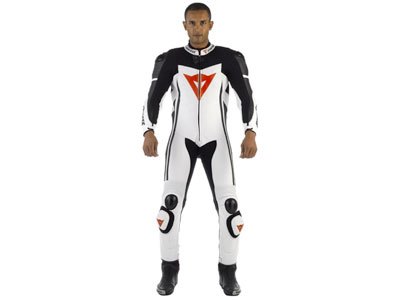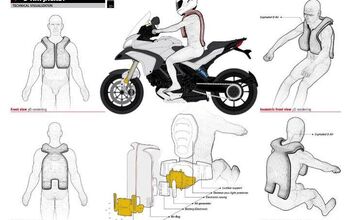Dainese D-Air Race Suit Announced for Production
After 10 years of research and development, and as announced early this month at the EICMA show in Milan, Dainese’s D-Air race airbag suit system is being released for sale to track day riders and racers in Europe.
U.S. consumers should see it for sale stateside by 2012.
While those following D-Air’s development have speculated Dainese might pin an astronomical price to the fruit of its multi-million dollar project, the company says it will charge 2700 euros, which works out to around $3,700.
Although this is still about three times more than many off-the-rack suits, D-Air suits will be custom-tailored to buyers’ measurements and include data-acquisition capabilities, such as lap times, speeds and mapping capabilities. It will therefore offer the same degree of fit, safety and technology that Valentino Rossi and other top racers get.
Dainese normally charges 40% extra for custom tailoring, and the price compares to some primo off-the-rack and custom suits which do not offer the same level of protection.
The D-Air system adds just 650g (1.43 lbs) to a standard suit, and the high-pressure, five-liter bladder reportedly reduces impact forces by a rather astonishing 90% compared to a traditional suit. Specifically, a 23-24 kN force would be reduced to just 1-2 kN, says Dainese.
The D-Air suit is a completely armored suit in addition to the underlying airbag, so that if the “cold gas generator” failed to inflate it, the rest of the armor would still be in place.
The airbag is said to be able to trigger in 15 milliseconds, deploy in 30 milliseconds and designed to prevent injuries most common in race track crashes. It compresses and guards some upper internal organs, the shoulder blades, collarbone, upper spine, and prevents the helmeted head from hyperextension, hyperflexion, and resultant neck injury.
As we previously reported, the D-Air system utilizes three gyroscopes, three accelerometers, a GPS, is completely wireless and encased in an impact-resistant Nidaplast-protected speed hump. The thought to use a cable tethered to the bike to actuate the system like some less expensive air vests and jackets do was never considered, as that was deemed inconvenient and encumbering.
Dainese is calling D-Air an “intelligent” technology because it assesses the violence of a potential fall and uses complex algorithms to determine when to deploy, and when not to.
The company says it’s certain the race technology is ready after logging a few years' race R&D time totaling over 5,000 hours thus far, and having recruited help from some of the brightest transportation safety engineers in Europe to make the suit possible.
An earlier prototype (with the airbag on the outside of the suit) was first seen successfully deploying in a 2007 crash by a 250cc GP racer at Valencia. Final testing in its present form (with airbag inside the suit) was done by elite “beta” testers in the 2009 and 2010 seasons.
The European gear maker says it has 13 patents applied for, is presently undergoing TÜV SÜD certification, in addition to meeting CE and several other certification standards.
The internally located airbag appears to be an elegant solution in that it is self-contained in a flexible abrasion-resistant material that will recompress the airbag after it blows. Another well-publicized incident of its use was documented at Valencia in Nov. 2009 in which Jorge Lorenzo began a highside but amazingly recovered. The suit inflated, but cost to his lap time was just 0.2 second. Another time after a crash at Brno, Lorenzo’s suit did not deflate, but he said he was still happy he had the suit on, and expressed trust for the technology. Other racers, including Rossi have gone on record praising D-Air after testing it firsthand, including its successful deployment for a crash at Mugello.
The suit is further distinguished by its German-developed 2D telemetry data-acquisition technology, as used by MotoGP and F1 auto race teams. This system utilizes the suit’s GPS and 2-gigabyte memory powered by a lithium-ion battery to provide data which can be downloaded to a computer.
This technology will be compatible with Google Earth, able to provide lap times, acceleration data, other speed data, assessment of braking and lines through corners, ability to plot lines on a map, and more.
The suit comes with an LED interface, and data acquisition options will include additional colors to evaluate variables (speed, acceleration, etc.), and ability to produce two-dimensional graphs of two parameters in relation to time. It will also have ability to create lateral and longitudinal acceleration diagrams to assess motorcycle traction, riding style, and more.
Dainese says this is just the beginning. Plans are to also introduce a D-Air street line, and ultimately make the technology available worldwide.
Street models will have more frontal protection based on the assumption that riders may slam into something like one of our nation’s untold millions of irresponsible distracted drivers who may be focusing on things other than the road in front of them.
Yes, that was a quasi-editorial comment, and, yes, it is based on fact and reflective of today’s reality.
In September this year, the U.S. Department of Transportation held its second annual “Distracted Driving Summit,” in which Transportation Secretary Ray LaHood said “distracted driving remains an epidemic in America.” In 2009 the USDOT estimated 5,474 deaths and 448,000 traffic injuries resulted from distracted drivers. And these numbers are “just the tip of the iceberg,” said LaHood.
In a world where it’s not even very safe for the auto and truck drivers, we think anything that contributes to unobtrusive, defensive motorcycle safety can’t be a bad idea.
While Dainese might have charged far more money, it would also appear it intends to recoup its R&D expenses long term from this complex technology not just from racers but also street riders purchasing jackets and vests. Undoubtedly also, Dainese has at least one eye on Alpinestars which is developing a similar technology seen in this article.
Alpinestars’ outside communications rep, Tim Collins, says A-Stars’ version will be made available worldwide in June, 2011. It will sell for about $5,000, be off-the-rack, but with potentially limited supply in the States.
As we reported earlier this year, it would appear an airbag suit technological race is indeed on, with both Italian companies working hard to bring these new paradigm products to market after a decade of proving them.
Get the Flash Player to see this player.
At this juncture, with custom fit and telemetry data included for 25% less, it would certainly appear that Dainese is offering more for less, albeit to a European audience only for the moment.
Dainese did not offer any estimated production date for the street versions, but says they are being developed and tested now, and will be brought to market as soon as possible.
Related Reading
2010 Dainese Lineup Unveiled
2010 Alpinestars Electronic Airbag Technology
Dainese D-Air launching at EICMA
More by Jeff Cobb



































Comments
Join the conversation